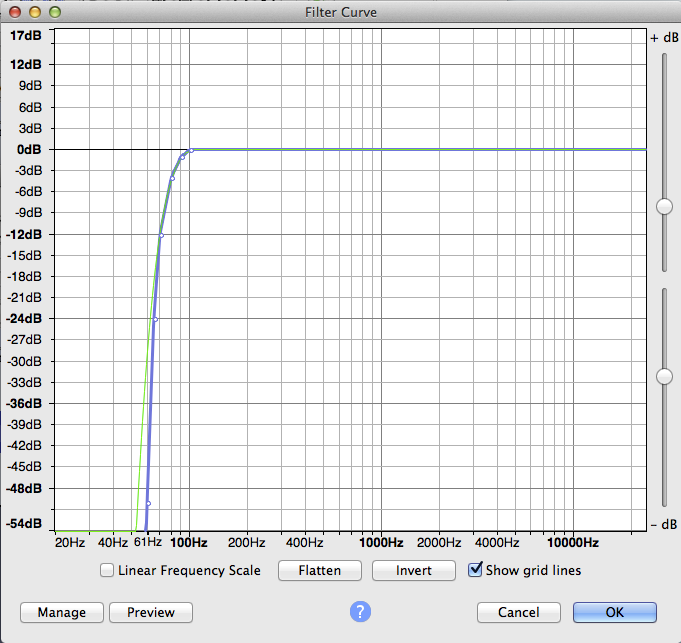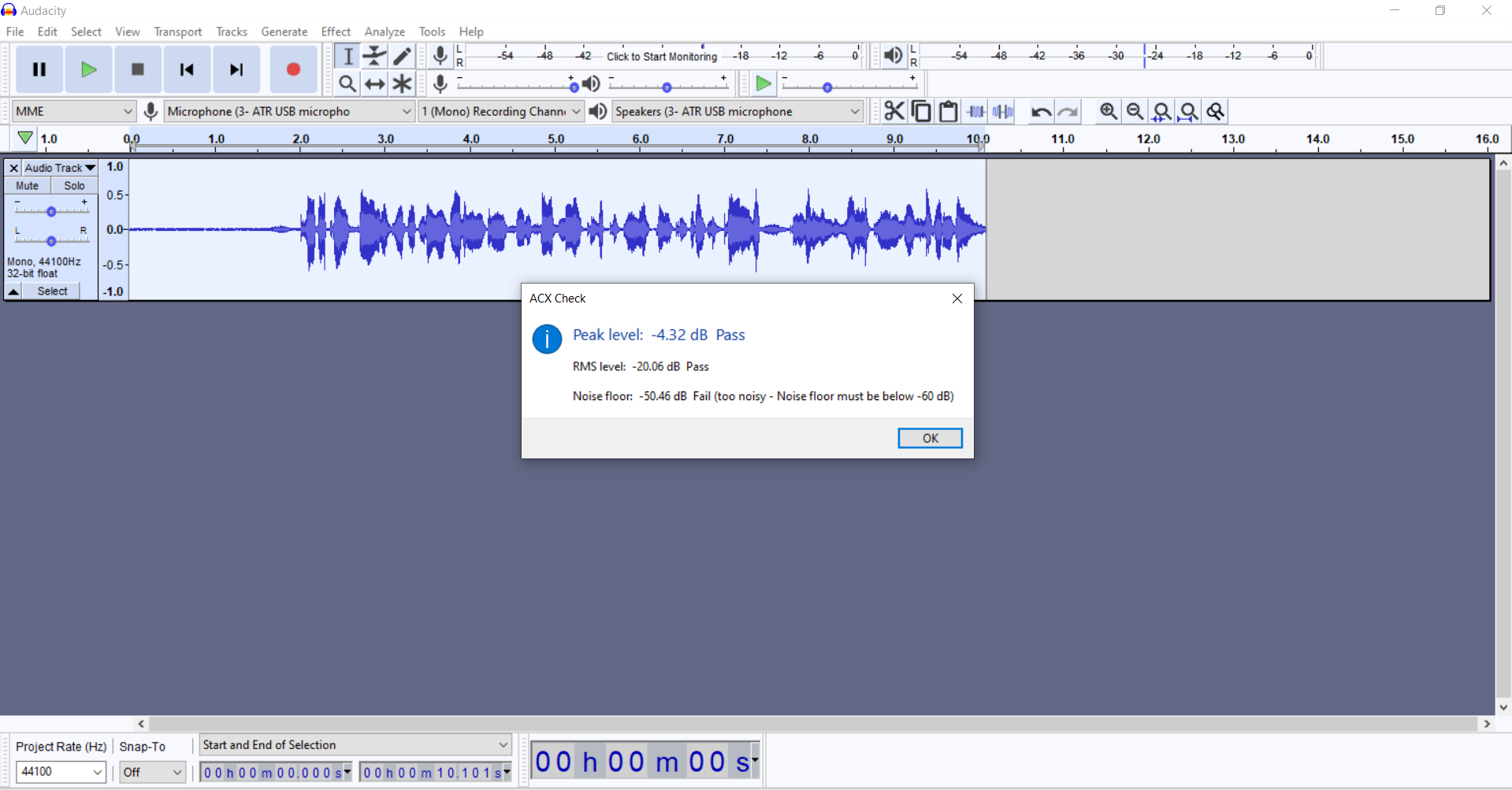Dumb question, but I got the 2.3.3 update today and was wondering how to adjust the filter length for the “Filter Curve” (or Equalisation). You used to be able to adjust it, was it scrapped, or am I just blind? I’m having to re-do my Macro (or ‘Chain’) and going through the fiddley bits.
I was wondering when that was going to pop up.
The old Equalizer had quality issues. When you used it, it would present with two different curves.
The blue one you (or the preset) drew operated in the subjunctive. This would have been the effect you might have gotten had the tool followed our desire. The green curve was the one you actually got. It was a little sloppier.
The new tool, Effect > Filter Curve has no such error, or the error is smaller and better behaved. So there is no adjustment.
One critical feature of the effect is that it should have good suppression at 60Hz which is the power frequency in the US. This can help suppress microphone hum problems.
The 50Hz power (lower pitch) in the UK is easier to deal with. If you start the curve much higher pitch than about 100Hz, you can start to hear it working in the voice or performance.
It’s a juggling act.
This effect appears on many field sound mixers to help with popping and rumble cause by wind.
Koz
Thanks Kozikowski for the explanation. I’m not an audio tech-head, but this is good stuff to know. I’m really glad that I saved picture references of my old EQ specs. I do miss seeing the graph with the graphic EQ, it feels weird without it somehow.
I’m lost.
That’s a screen capture of Low Rolloff under Effect > Filter Curve in Audacity 2.3.3.

You can open the Low Rolloff in any text editor and transfer the points manually by dragging the curve around with your mouse.

For one example, the last point in the list is f=100 d=0.0. In English, voice tones at 100Hz (ballsy announcer low tones) are not affected by this filter. See the tiny circle in the green line above at the cross of 0dB and 100Hz?
Watch. I’ll grab it with my mouse and mess it up.

Its a pretty simple curve for all the tricks it does.
Koz
Hello
This is my first post to this forum. Thanks for making it available. Please excuse in advance my naivete and asking questions which may appear stupid.
This is my first attempt at making an audiobook. I use windows 10 and Audacity 2.3.3
I have downloaded all the plug-ins I am aware exist. You referred to an ‘equalization’ effect I can’t find anywhere. Is this the same as normalization?
When I manage to get peak values below -3dB the RMS shoots above 23dB and when I try to get the RMS below 23dB, peak values rocket above -3dB. How do I conciliate both? Does a plug-in exist to achieve that?
I have been doing this for several hours tweaking figures without any success.
Many thanks in advance for your help.
It’s now called “Filter Curve” and it’s now become easier to use (no need to set a “Size” parameter - that’s now automatic).
https://manual.audacityteam.org/man/filter_curve.html
In the next version of Audacity it will probably be called “Filter Curve Eq” (or something similar).
When I manage to get peak values below -3dB the RMS shoots above 23dB
There is an audiobook suite of tools that can deal with all that.
That’s the detailed step by step. This is the quick version.
If your original voice recording is loud enough and you recorded in a very quiet room, you may be done.
But back here on Earth; that never works. Home recordings never pass noise. Between the computer fan noise, refrigerator, (fish tank in one case) and the metrobus outside, noise is a constant struggle for home performers. The ACX Audiobook specification for background noise is -60dB. In English, that means your background noise has to be 1000 times quieter than your speaking voice. That’s not a typo.
Record a test (if you’re set up enough) and I’ll run it through mastering and see how it goes.
http://www.kozco.com/tech/audacity/TestClip/Record_A_Clip.html
Read down the blue links. They’re very short.
Koz
dB or Decibel Relationships
<— Quieter ———————— Louder —>
-65dB, -60dB, -23dB, -18dB, -3dB, 0dB
That’s all the audiobook dB specifications.
— Maximum volume is 0dB. Sound gets quieter with negative numbers.
— -3dB is the loudest audiobook peak sound value.
— RMS or loudness needs to hit between -18dB (louder) and -23dB (quieter).
— Noise value has to be quieter than -60dB.
Noise is the troublesome one. Actual submitted performance background noise should be quieter than -65dB in real life. There is no submitting performance noise of -60.2dB, for example. Technically, that does pass, but sooner or later, one of your audiobook chapters is going to fail Noise and you will need to apply noise reduction or some other fix. That fix may make one chapter not match the others and that violates the ACX law that all your chapters match.
https://forum.audacityteam.org/t/measure-between-23db-and-18db-rms/32770/16
It’s possible to use dB for measurements other than the above. You can use them in comparisons. “My voice recording is 3dB louder than yours.”
Sound Pressure Level measures sound volume in free air with special meters. DB SPL uses positive numbers. “My truck engine sound measures 125dB SPL” (threshold of pain). There is no direct relationship between dB (audiobook, above) and dB SPL. Some Phones claim to be able to measure dB SPL directly.
Koz
Hallo vielmals,
finde in der Version 4.2.1. Roloff of speach nicht. Den Equalizer, der diese Funktion in den älteren Versionen beinhaltet hat, lässt sich nicht aktivieren. Benutze jetzt Filtercurve. Ist das in Ordnung?
Vielen Dank für Eure Antworten.
Hermann
Hello,
I’m attaching the test file as described above.
I can see a problem right away. My peaks only reach about -25. I have the mic cranked to 100 both in Audacity and in the laptop’s control panel. I’ve also tried using a different USB port, without much improvement. I’m using an aged Audio-Technica ATR2100 microphone. Some Googling has revealed that low recording levels are a problem with this particular model, but I used to record podcasts and video voiceovers way back when with this mic and I never encountered this problem before. Though mic placement might be a factor. I used to hand-hold the mic right in front of my mouth before. Now I have the mic suspended a few inches from my mouth, as advised by the ACX audiobook recording tutorials.
My attempts to fix the low level in Audacity using the Filter Curve, RMS Normalize and Limiter make the noise floor way too high. See attached screen shot.
Any ideas?
Thank you,
Leif

